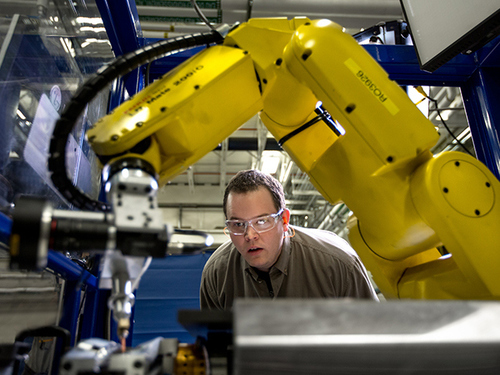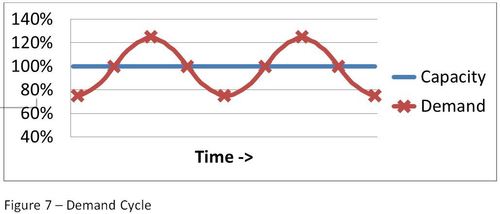Nov 21 2013
Stop ropes and Andons at Ford’s River Rouge Plant in 1931
Mark Warren pointed out to me the description of a stop rope with and Andon board in a book called Ford Men and Methods, by Edwin P. Norwood, with illustrations by Charles Sheeler, including his famous crossing conveyors.
First, on p. 1:
“Placed on one of many balconies to be found in the Rouge Plant Motors Building is a room, glassed on three sides and so located as to command a comparatively clear view of all that surrounds it. Along the back wall of this room stands an instrument board, studded with signal lights.
Aside from their visitor, two men are present. One, seated on a stool, is drawn close to a shallow desk which extends from the board. The other, a trouble mechanic, is intent upon that constant motion to be seen through the windows.
As you watch there comes the whir of a bell fixed to the top of the panel. The man at the desk moves a switch. The bell is silenced but in the same instant a green light glows in the face of the board. The operator waits-one eye on a clock that is near the bell, the other on the emerald light.
Five seconds, ten seconds, twenty seconds–then the light goes dark. Already the man’s finger is on a convenient button. He presses it twice and to your ears come the drawn-out wails of a distant siren. He touches a second button and somewhere a conveyor, temporarily “down,” goes into action again. You have had a fleeting glimpse of one of the control centers of that huge System of power-driven carriers that move throughout seemingly every nook and corner of the Dearborn shops.”
Following is a picture of an Andon board from Toyota Georgetown today:

Unlike the example described above, it is not located in a control room but on the shop floor for production supervisors to see, and green lights are not used for alarms anymore. Perhaps, in 1931, the green-yellow-red color code had not yet become a cultural constraint.
Then on p. 10:
“The operator is provided with the means of protecting himself against accident or the chance of becoming swamped by a too rapid flow of work. If materials are coming too
fast, as at some point where there is a transfer from one line to another, or if an unlooked-for hitch tangles the smoothness of movement, any Workman is at liberty to bring that line at which he is engaged to a halt. Indeed, he is expected to do so. He does this by throwing a switch, or by reaching upward and pulling a cord which operates similarly to that used for signaling the driver in a motor bus.To make clearer this provision it may be well to return to the control booth touched upon at the beginning of the present chapter. The glowing of the green light noted at that time simply meant that somewhere some operator or foreman had pulled a stop switch. The trouble determining this action may have been a minor difficulty, or it may have been of serious import — possibly an actual breakdown of machinery. In such instances the probability is judged by the booth operator in accordance with the space of time that the signal light burns. If more than two minutes pass, then the trouble mechanic serving the affected section investigates the cause. And he knows where to go because of the number and position of the light on the instrument board. But if the light is extinguished within the permitted two minutes, this is because an electrical impulse meaning ‘All’s well’ has been sent in from the point of temporary trouble. It is then that the siren is sounded –a warning to all interested that the line is once more to move — while the pushing of the second button sends the conveyor into action again. But whatever the space of time may have been, the control operator tabulates both it and the point of trouble.”

The description of the stop rope matches exactly this picture from Toyota Georgetown, and it still resembles the cord on a city bus that you pull to tell the driver to let you off at the next stop.




Nov 22 2013
Manufacturing in America Infographic | U.S. Census Bureau
See on Scoop.it – lean manufacturing
 “Manufacturing plays a major role in our economy. According to the Census Bureau’s latest County Business Patterns, the manufacturing sector includes almost 300,000 establishments with 11 million employees producing goods that we consume domestically or export abroad. The nation relies on several key Census Bureau programs to track America’s manufacturing. The most recent year’s data from some of these programs are highlighted below.”
“Manufacturing plays a major role in our economy. According to the Census Bureau’s latest County Business Patterns, the manufacturing sector includes almost 300,000 establishments with 11 million employees producing goods that we consume domestically or export abroad. The nation relies on several key Census Bureau programs to track America’s manufacturing. The most recent year’s data from some of these programs are highlighted below.”
These are the official numbers about the place of Manufacturing in the economy, in terms of employment, geographical distribution, materials consumption, energy consumption, capital investment, value of shipments, and contribution to exports.
In the US, we are lucky to have government agencies that compile unbiased economic statistics, and make much of the raw data available on line.
If you want to know the valued added per employee of an industry, or its ratio of indirect to direct employees, you can get the numbers from the Bureau of Labor Statistics and the Economic Census.
As one would expect, the value added per employee is higher in semiconductors than in aluminum foundries. But the industry on the West Coast that, in aggregate, produces the most value added is computer assembly, and that, I didn’t expect.
See on www.census.gov
Share this:
Like this:
By Michel Baudin • Press clippings 0 • Tags: Census, Economic Census, Economic statistics, Manufacturing